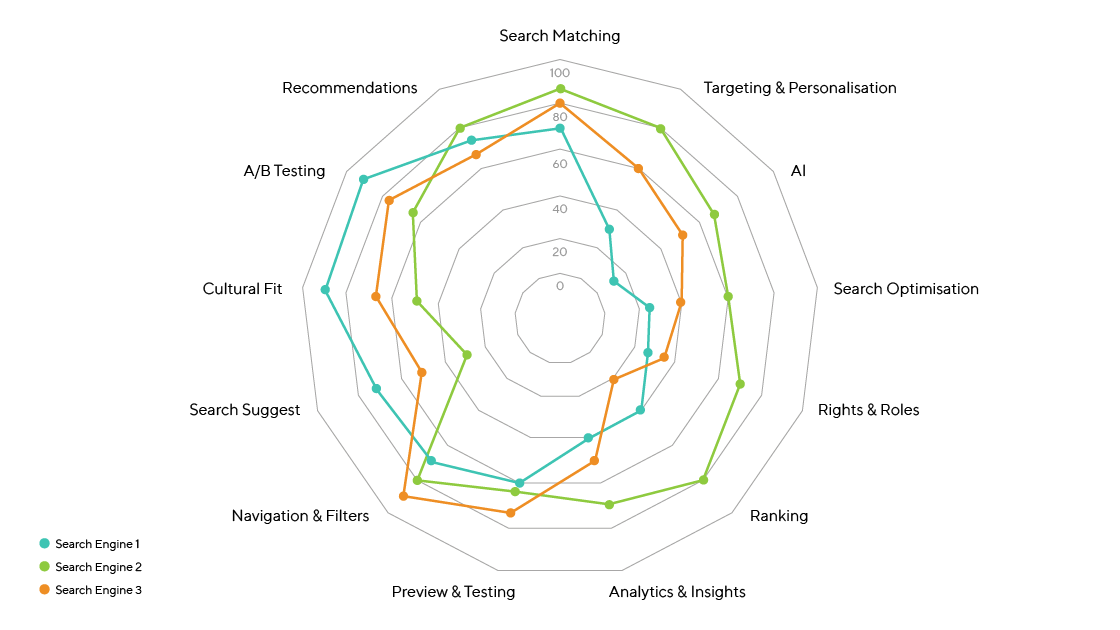Finding the perfect search: How to choose a custom-fit e-commerce search for your business.

Showing the right products to the right customers at the right time has always been a basic requirement for retailers and manufacturers. In the digital space, this still largely takes place in online stores or digital product catalogs, although the multichannel reality is of course much more complex.
Providers of e-commerce search technology, also known as Search & Discovery or Digital Commerce Search, offer a wide range of functions related to the management of search, navigation/filtering, merchandising, ranking, recommendations and personalization. They promise their customers noticeable increases in conversion rates and average shopping cart values; of course, everything is automated as much as possible with the support of artificial intelligence. But which providers keep their promises? How many of the functions do you really need? Is an open source solution perhaps enough? And how can I efficiently find the best solution for my company in a rapidly changing market?
The e-commerce search technology market is complex and confusing. There are a large number of providers, some of which are difficult to compare with each other in terms of their functions. First, there are the well-known open source search technologies such as Solr or ElasticSearch, which are flexibly adaptable and applicable to all possible catalogs; sufficient technical expertise in search technology is a prerequisite and thus often recommended by IT. If you want to make things a little easier, you can also use a search with basic functionalities that is delivered out-of-the-box in the e-commerce platform. These typically offer less flexibility, but are enticing in that there are supposedly no additional costs due to licenses or development. However, if you recognize the potential of search and focus on optimizing sales metrics and customer satisfaction, which are crucial factors for business success, you can integrate a fully professional, SaaS-based enterprise search solution according to the best-of-breed model, which is equipped with a whole range of commerce-specific functions and a backend for marketing and store management.
Digital commerce, a selection of search engines

The choice of e-commerce search is often not only a technical one, but also a cultural one
The range of technologies is long and a complete market overview is not possible given the time available. The pre-selection is therefore often determined by very few criteria: The geographic presence of the providers, known reference customers, personal recommendations and brand awareness. Particularly with regard to the last aspect, caution is called for, because people often place their trust in technologically inferior solutions because they have been on the market for a long time or invest a particularly large amount of money in marketing in the home region (buzzword: Familiarity Bias). As a result, truly exciting technologies are often lost from view. Here, it helps to involve external experts early on in the selection process.
Functional and technical requirements naturally also play an important role in the selection process. By now, most decision-makers have probably noticed that the classic Excel list RfP does not lead to a smaller list of providers. On the one hand, this is due to the fact that too many basic functions are requested, which all providers cover anyway. On the other hand, however, it is also due to the fact that the functions leave too much room for interpretation and thus a "Yes, we can" fulfills the formal criterion, but the second sub-sentence "but with very high effort" is omitted. Instead, it is advisable to extract the really exciting differentiation criteria and then go deeper into the exchange with the providers together with experts.
Search engine comparison based on technical factors

In the end, it usually boils down to the fact that several providers come into question from a technical and functional point of view. The really crucial question is then whether the provider and the company are also a good cultural fit. Has trust grown in the course of getting to know each other? How well do the people involved harmonize with each other? Are there local contacts who can provide me with their expertise? Do the people have the confidence to solve future problems together? Will the people involved still be there in the future, or is the company a pawn in mergers and acquisitions? In people business, these are fundamental prerequisites for a good partnership.
How the Exploded View method assists in the selection process
The Exploded View model by Jonathan Möller (www.explodedview.com) is very well suited for viewing the selection of an e-commerce search in the context of customer needs, channel experiences, organization and processes, system landscape and data. Suitable modeling methods are used to efficiently and easily create an image of the company's reality for this purpose, in order to design the desired target state based on it. The method supports networked thinking across the six levels, provides the basis for comprehensive planning of the system introduction and creates transparency for all participants.
The Exploded View thus ensures that the system introduction is not viewed as primarily a technical challenge, but that the customer benefits are understood, organizational and process-related changes are taken into account and the technical solution is implemented in the context of the environment. Put simply, the chances of success of a system selection and introduction are massively increased by the networked thinking that this promotes.
Who should be involved in the evaluation?
An optimal evaluation team is led by a product owner for the search & discovery functionalities in the online store or product catalog. The product owner ensures that the solution decision is made from a business perspective. He is supported by other business representatives who then work with the solution. In most companies, these are the brand managers or store managers. IT should definitely support, but not lead the process. This is important because e-commerce search is not a technical task at its core, but a marketing task. In many companies, this is classified differently, with the result that the quality of the resulting solution does not achieve the optimal effect. Ultimately, of course, e-commerce management and, especially in corporate groups, purchasing and other relevant stakeholders must also be involved. In order not to forget anyone, it is often worthwhile to create a stakeholder overview.
When is the right time to evaluate?
Are you dissatisfied with the quality of your e-commerce search? Would you like to find out if there are better solutions on the market? Is a contract renewal of your existing software license coming up soon? Are the costs of your existing solution too high? There are a variety of reasons why an evaluation might make sense, but the effort should be worth it. Our Search & Discovery team will be happy to conduct a status quo analysis to help you decide whether you are still well positioned with your current solution or whether a change would be worthwhile.
If you are interested in the topic, please contact Jens Plattfaut, Managing Director of foryouandyourcustomers in Munich and Long Do, Senior Search & Discovery Expert. They will be very happy to help.
#searchanddiscovery #ecommerce #foryouandyourcustomers
